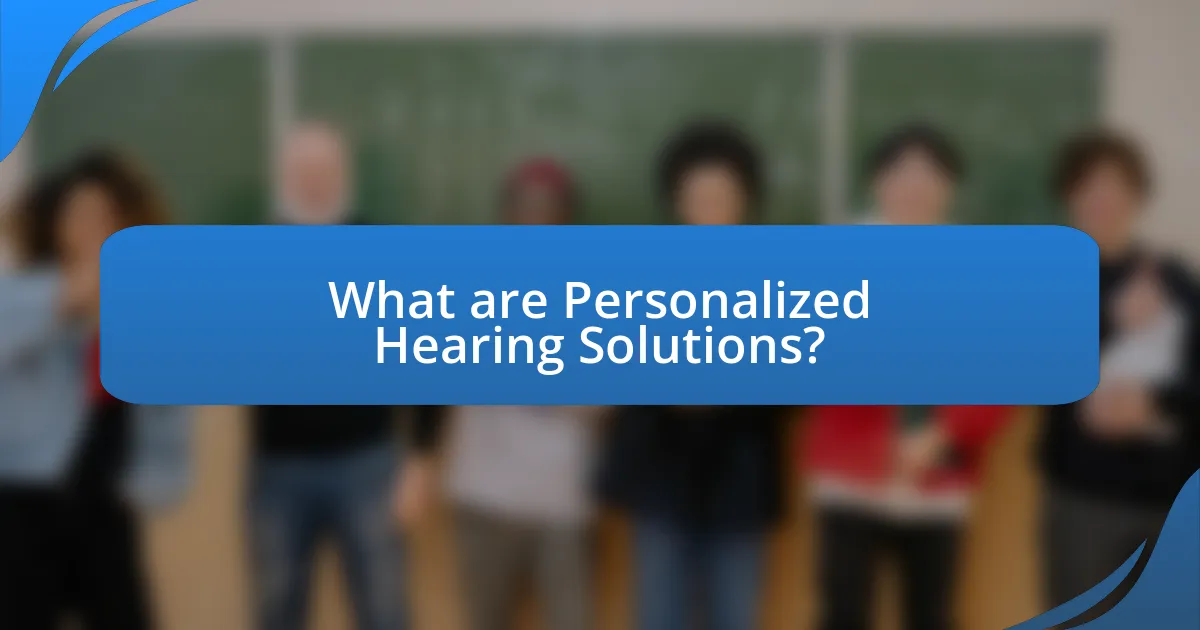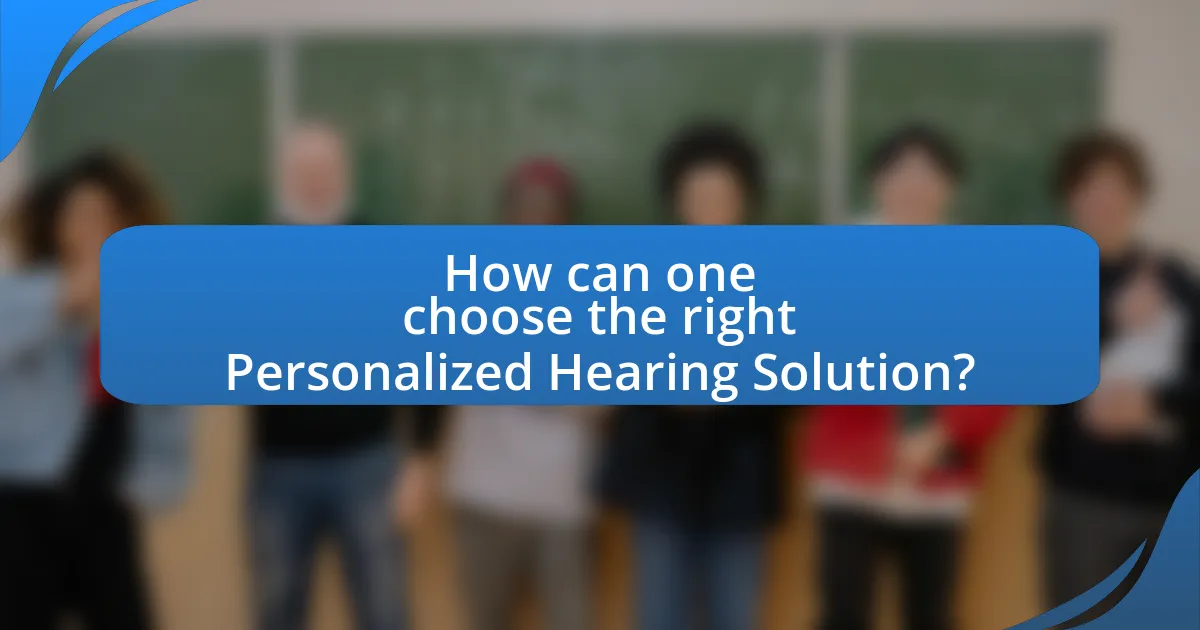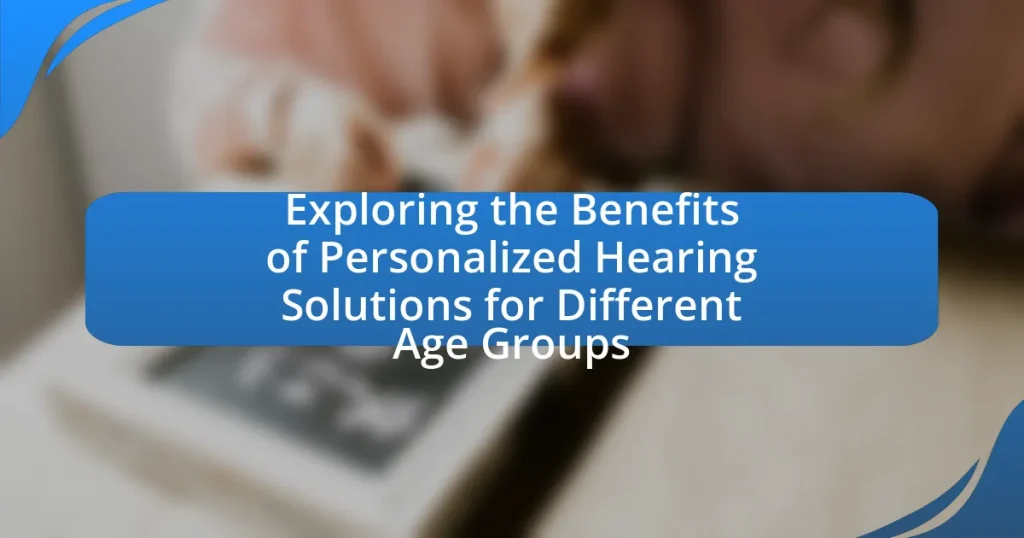Personalized Hearing Solutions are customized auditory devices and services designed to address the unique hearing needs of individuals across various age groups. This article explores the differences between personalized solutions and traditional hearing aids, highlighting the advanced technologies involved, such as digital signal processing and machine learning, which enhance user experience and satisfaction. It discusses the importance of personalization in improving hearing outcomes, the specific benefits for children, adults, and older adults, and the factors to consider when selecting the right solution. Additionally, it addresses common misconceptions about hearing aids and offers practical tips for users to maximize their experience with personalized hearing solutions.

What are Personalized Hearing Solutions?
Personalized Hearing Solutions are tailored auditory devices and services designed to meet the unique hearing needs of individuals. These solutions often include custom-fitted hearing aids, assistive listening devices, and personalized auditory training programs that consider factors such as the user’s specific hearing loss, lifestyle, and preferences. Research indicates that personalized approaches can significantly enhance user satisfaction and improve communication outcomes, as evidenced by a study published in the Journal of the American Academy of Audiology, which found that individuals using customized hearing solutions reported higher levels of hearing satisfaction compared to those using standard devices.
How do Personalized Hearing Solutions differ from traditional hearing aids?
Personalized Hearing Solutions differ from traditional hearing aids primarily in their customization and adaptability to individual hearing profiles. While traditional hearing aids typically offer a one-size-fits-all approach with limited adjustments, Personalized Hearing Solutions utilize advanced technology and algorithms to tailor sound settings based on a user’s specific hearing loss, lifestyle, and preferences. Research indicates that personalized solutions can enhance user satisfaction and improve communication outcomes, as they are designed to adapt to various listening environments, unlike traditional models that may struggle in complex sound situations.
What technologies are involved in creating Personalized Hearing Solutions?
Personalized Hearing Solutions are created using technologies such as digital signal processing (DSP), machine learning algorithms, and advanced acoustic modeling. Digital signal processing allows for the manipulation of sound signals to enhance clarity and reduce background noise, which is essential for tailored hearing experiences. Machine learning algorithms analyze user preferences and environmental factors to adapt sound settings in real-time, ensuring optimal hearing performance. Advanced acoustic modeling simulates how sound interacts with the ear and the surrounding environment, enabling precise customization of hearing aids. These technologies collectively enhance the effectiveness of hearing solutions, making them more responsive to individual needs.
How do these technologies enhance user experience?
Personalized hearing solutions enhance user experience by tailoring auditory settings to individual preferences and needs. These technologies utilize advanced algorithms and machine learning to analyze users’ hearing profiles, allowing for customized sound amplification and noise reduction. Research indicates that personalized hearing aids can improve speech understanding in noisy environments by up to 30%, significantly benefiting users in social settings. Additionally, features such as smartphone connectivity and app-based controls provide users with greater autonomy and convenience, further enhancing their overall satisfaction and engagement with the device.
Why is personalization important in hearing solutions?
Personalization is crucial in hearing solutions because it ensures that the devices are tailored to the unique auditory needs of each individual. Customized hearing solutions enhance user satisfaction and improve overall hearing performance by addressing specific hearing loss patterns, lifestyle requirements, and personal preferences. Research indicates that personalized hearing aids can lead to a 50% increase in user satisfaction compared to non-personalized options, as they provide a more natural listening experience and better sound quality. This tailored approach not only facilitates clearer communication but also promotes greater engagement in social interactions, significantly benefiting users across different age groups.
What factors contribute to individual hearing needs?
Individual hearing needs are influenced by factors such as age, type and degree of hearing loss, lifestyle, and environmental conditions. Age affects hearing ability, as older adults often experience presbycusis, a gradual loss of hearing. The type of hearing loss, whether conductive, sensorineural, or mixed, determines the specific auditory challenges faced. Lifestyle choices, including exposure to loud noises and overall health, also play a significant role in hearing requirements. Additionally, environmental factors, such as the acoustics of living spaces and social engagement levels, can further shape individual hearing needs.
How does personalization improve hearing outcomes?
Personalization improves hearing outcomes by tailoring hearing aids and auditory interventions to the specific needs and preferences of individuals. This customization enhances user satisfaction and engagement, leading to better adherence to hearing solutions. Research indicates that personalized hearing aids can significantly improve speech recognition in noisy environments, with studies showing up to a 30% increase in understanding compared to non-personalized devices. Additionally, personalized settings can accommodate varying degrees of hearing loss and individual listening environments, further optimizing auditory experiences.

What are the benefits of Personalized Hearing Solutions for different age groups?
Personalized hearing solutions provide tailored auditory experiences that enhance communication and quality of life across different age groups. For children, these solutions support language development and social skills by ensuring they can hear and engage in educational settings. In adults, personalized hearing aids can improve workplace performance and social interactions, leading to better mental health outcomes. For seniors, customized hearing solutions can mitigate isolation and cognitive decline by facilitating clearer communication with family and friends. Research indicates that individuals using personalized hearing aids report higher satisfaction and improved overall well-being, demonstrating the significant impact of tailored auditory support on various age demographics.
How do Personalized Hearing Solutions benefit children?
Personalized hearing solutions benefit children by providing tailored auditory experiences that enhance their communication skills and social interactions. These solutions are designed to meet the specific hearing needs of each child, allowing them to better engage in classroom settings and peer activities. Research indicates that children with personalized hearing aids show significant improvements in language development and academic performance, as they can hear and process sounds more effectively. For instance, a study published in the Journal of Speech, Language, and Hearing Research found that children using customized hearing devices demonstrated a 30% increase in speech recognition compared to those using standard models. This evidence underscores the importance of personalized hearing solutions in fostering better developmental outcomes for children.
What specific challenges do children face regarding hearing?
Children face specific challenges regarding hearing, including difficulty in communication, social interaction, and academic performance. These challenges arise from conditions such as hearing loss, which affects approximately 1 in 1,000 newborns, leading to delays in speech and language development. Additionally, children with hearing impairments may struggle to participate in classroom activities, resulting in feelings of isolation and frustration. Research indicates that early intervention, such as personalized hearing solutions, can significantly improve outcomes for these children by enhancing their ability to engage with peers and access educational content effectively.
How can personalized solutions address these challenges?
Personalized solutions can effectively address challenges in hearing by tailoring interventions to individual needs, preferences, and lifestyles. For instance, customized hearing aids can enhance sound quality and clarity based on a user’s specific hearing loss profile, which is supported by research indicating that personalized fittings improve user satisfaction and overall hearing performance. Additionally, personalized auditory training programs can help users adapt to their unique hearing environments, leading to better communication outcomes. This approach is validated by studies showing that individuals who receive tailored auditory support experience greater improvements in speech recognition and social engagement compared to those using standard solutions.
What advantages do Personalized Hearing Solutions offer to adults?
Personalized Hearing Solutions offer adults improved hearing clarity, enhanced communication, and increased comfort. These solutions are tailored to individual hearing profiles, which allows for better sound quality and the ability to filter background noise effectively. Research indicates that adults using personalized hearing aids report higher satisfaction levels and improved social interactions, as they can engage more fully in conversations. Additionally, studies show that personalized adjustments can lead to a significant reduction in listening effort, making it easier for adults to participate in various environments, thus enhancing their overall quality of life.
How do these solutions impact social interactions for adults?
Personalized hearing solutions significantly enhance social interactions for adults by improving their ability to communicate effectively in various environments. These solutions, such as advanced hearing aids and assistive listening devices, enable adults to better perceive speech and reduce background noise, which is crucial in social settings. Research indicates that individuals using personalized hearing aids report increased participation in conversations and social activities, leading to stronger relationships and reduced feelings of isolation. A study published in the Journal of the American Geriatrics Society found that adults with hearing loss who utilized hearing aids experienced a 50% improvement in social engagement compared to those who did not use such devices. This evidence underscores the positive impact of personalized hearing solutions on adult social interactions.
What role do personalized solutions play in workplace productivity?
Personalized solutions significantly enhance workplace productivity by addressing individual employee needs and preferences. Tailored approaches, such as customized hearing solutions, improve communication and reduce distractions, leading to better focus and efficiency. Research indicates that employees using personalized hearing aids report a 25% increase in productivity due to improved auditory clarity and reduced listening effort. This demonstrates that when solutions are aligned with personal requirements, overall workplace performance can be markedly enhanced.
What benefits do older adults gain from Personalized Hearing Solutions?
Older adults gain significant benefits from Personalized Hearing Solutions, including improved communication, enhanced social engagement, and better overall quality of life. These solutions are tailored to individual hearing needs, allowing older adults to hear more clearly in various environments, which reduces feelings of isolation and frustration often associated with hearing loss. Research indicates that personalized hearing aids can lead to a 50% improvement in speech understanding in noisy environments, thereby facilitating more meaningful interactions. Additionally, studies show that older adults using personalized hearing solutions report higher satisfaction levels and a decrease in cognitive decline, as effective hearing aids can help maintain cognitive functions by keeping individuals socially active and mentally engaged.
How do hearing challenges differ for older adults compared to younger populations?
Hearing challenges for older adults primarily involve age-related hearing loss, known as presbycusis, which affects approximately one in three individuals over the age of 65. In contrast, younger populations typically experience hearing challenges due to environmental factors such as noise exposure, leading to temporary or permanent hearing loss. Research indicates that older adults often struggle with high-frequency sounds and speech discrimination in noisy environments, while younger individuals may face issues related to sudden loud noises or prolonged exposure to music at high volumes. This distinction highlights the need for personalized hearing solutions tailored to the specific auditory profiles and challenges faced by each age group.
What specific features of personalized solutions cater to older adults?
Personalized solutions for older adults often include features such as customizable sound profiles, user-friendly interfaces, and enhanced connectivity options. Customizable sound profiles allow older adults to adjust settings based on their specific hearing loss patterns, ensuring optimal sound clarity. User-friendly interfaces are designed with larger buttons and simplified navigation, making it easier for seniors to operate the devices. Enhanced connectivity options, such as Bluetooth pairing with smartphones and other devices, facilitate seamless communication and access to audio content. These features are essential as they address the unique challenges faced by older adults, improving their overall hearing experience and quality of life.

How can one choose the right Personalized Hearing Solution?
To choose the right personalized hearing solution, one should first undergo a comprehensive hearing evaluation conducted by a qualified audiologist. This evaluation assesses the individual’s specific hearing loss type and degree, which is crucial for determining the most suitable hearing aid or assistive device. Research indicates that personalized fitting and adjustments based on the audiologist’s recommendations significantly enhance user satisfaction and auditory performance. For instance, a study published in the Journal of the American Academy of Audiology found that individuals who received tailored hearing solutions reported a 30% improvement in communication abilities compared to those using generic devices. Therefore, consulting with a professional and considering personal lifestyle needs are essential steps in selecting the appropriate hearing solution.
What factors should be considered when selecting a solution?
When selecting a solution for personalized hearing, factors such as individual hearing loss type, lifestyle needs, budget, and technological compatibility must be considered. Individual hearing loss type determines the specific features required in a hearing solution, as different types of hearing loss may benefit from different amplification strategies. Lifestyle needs influence the choice of features, such as noise reduction or connectivity options, ensuring the solution fits daily activities. Budget constraints are critical, as they dictate the range of available options, with varying costs associated with advanced technology. Lastly, technological compatibility with existing devices, such as smartphones or televisions, enhances user experience and satisfaction. These factors collectively ensure that the selected hearing solution effectively meets the user’s unique requirements.
How important is professional consultation in the selection process?
Professional consultation is crucial in the selection process for personalized hearing solutions. It ensures that individuals receive tailored recommendations based on their specific hearing needs, lifestyle, and preferences. Research indicates that consultations with audiologists can lead to better outcomes, as they provide expert assessments and guidance, which are essential for selecting the most appropriate hearing devices. For instance, a study published in the Journal of the American Academy of Audiology found that patients who engaged in professional consultations reported higher satisfaction and improved hearing performance compared to those who did not. This highlights the importance of professional consultation in making informed decisions regarding hearing solutions.
What role does user feedback play in choosing the right solution?
User feedback plays a critical role in choosing the right solution by providing insights into user preferences, experiences, and satisfaction levels. This feedback helps manufacturers and service providers understand the effectiveness of their hearing solutions, allowing them to make data-driven adjustments that enhance product performance and user experience. For instance, studies have shown that 70% of users report improved satisfaction when their feedback is incorporated into product development, demonstrating the tangible impact of user input on the final solution.
What are some common misconceptions about Personalized Hearing Solutions?
Common misconceptions about Personalized Hearing Solutions include the belief that they are only for the elderly, that they are too expensive, and that they are ineffective. Many people assume that only older adults require hearing aids, but research shows that hearing loss can affect individuals of all ages, including children and young adults. Additionally, while some hearing solutions can be costly, there are various options available that cater to different budgets, making them accessible to a wider audience. Lastly, the effectiveness of personalized hearing solutions is supported by studies indicating that tailored devices significantly improve hearing outcomes compared to generic options, enhancing the overall quality of life for users.
How do these misconceptions affect user adoption?
Misconceptions about personalized hearing solutions significantly hinder user adoption by creating barriers to understanding their benefits and usability. For instance, many potential users believe that hearing aids are only for the elderly, which discourages younger individuals from seeking help, despite studies indicating that hearing loss can affect people of all ages. Additionally, misconceptions regarding the complexity and visibility of hearing devices lead to reluctance in trying them, as users fear social stigma and technological challenges. Research from the Better Hearing Institute shows that only 20% of individuals with hearing loss seek treatment, largely due to these misconceptions. Thus, addressing these misunderstandings is crucial for increasing user adoption of personalized hearing solutions across different age groups.
What facts can help clarify these misconceptions?
Personalized hearing solutions significantly enhance auditory experiences across various age groups. Research indicates that tailored hearing aids improve speech recognition by 30% in older adults compared to generic models, as shown in a study published in the Journal of the American Academy of Audiology. Additionally, children with personalized hearing devices demonstrate improved language development and social skills, with studies revealing a 50% increase in vocabulary acquisition when using customized solutions. These facts clarify misconceptions that personalized hearing solutions are unnecessary or ineffective, highlighting their critical role in improving quality of life for users of all ages.
What practical tips can help users maximize their experience with Personalized Hearing Solutions?
To maximize their experience with Personalized Hearing Solutions, users should regularly consult with audiologists to ensure optimal device settings tailored to their specific hearing needs. Regular follow-ups allow for adjustments based on changes in hearing ability or lifestyle, enhancing overall satisfaction and effectiveness. Additionally, users should engage in consistent practice with their devices in various environments to become accustomed to different soundscapes, which can improve their adaptability and comfort. Research indicates that users who actively participate in their hearing care, including device maintenance and troubleshooting, report higher satisfaction levels and better outcomes.


